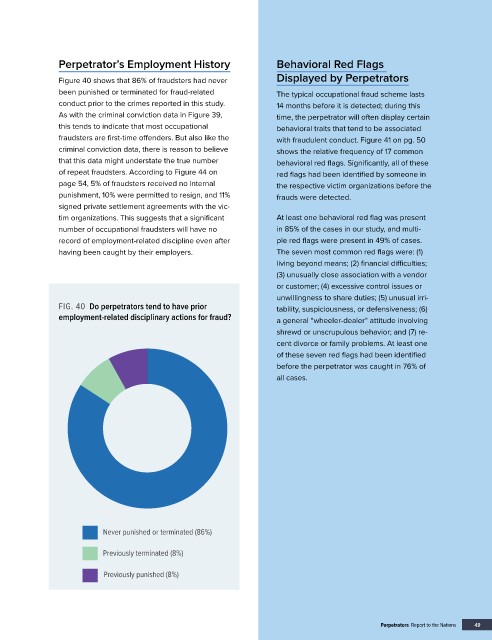Page 705 - ACFE Fraud Reports 2009_2020
P. 705
Perpetrator’s Employment History Behavioral Red Flags
Figure 40 shows that 86% of fraudsters had never Displayed by Perpetrators
been punished or terminated for fraud-related The typical occupational fraud scheme lasts
conduct prior to the crimes reported in this study. 14 months before it is detected; during this
As with the criminal conviction data in Figure 39, time, the perpetrator will often display certain
this tends to indicate that most occupational behavioral traits that tend to be associated
fraudsters are first-time offenders. But also like the with fraudulent conduct. Figure 41 on pg. 50
criminal conviction data, there is reason to believe shows the relative frequency of 17 common
that this data might understate the true number behavioral red flags. Significantly, all of these
of repeat fraudsters. According to Figure 44 on red flags had been identified by someone in
page 54, 5% of fraudsters received no internal the respective victim organizations before the
punishment, 10% were permitted to resign, and 11% frauds were detected.
signed private settlement agreements with the vic-
tim organizations. This suggests that a significant At least one behavioral red flag was present
number of occupational fraudsters will have no in 85% of the cases in our study, and multi-
record of employment-related discipline even after ple red flags were present in 49% of cases.
having been caught by their employers. The seven most common red flags were: (1)
living beyond means; (2) financial difficulties;
(3) unusually close association with a vendor
or customer; (4) excessive control issues or
unwillingness to share duties; (5) unusual irri-
FIG. 40 Do perpetrators tend to have prior tability, suspiciousness, or defensiveness; (6)
employment-related disciplinary actions for fraud?
a general “wheeler-dealer” attitude involving
Do perpetrators tend to have prior employment-related disciplinary actions for fraud?
shrewd or unscrupulous behavior; and (7) re-
cent divorce or family problems. At least one
of these seven red flags had been identified
before the perpetrator was caught in 76% of
all cases.
Never punished or terminated (86%)
Previously terminated (8%)
Previously punished (8%)
Perpetrators Report to the Nations 49

